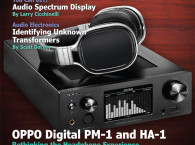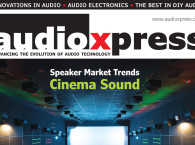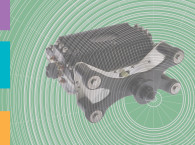Our super-sized September 2015 issue focuses on speaker design, from industrial/commercial to DIY perspectives. If you like speakers and are looking for new project ideas and new areas of product design, this edition of audioXpress is full of insights into how to approach DIY builds from new directions.
 Our cover feature discusses the surprising Powersoft M-System, which combines the M-Force motor transducer and the M-Drive switching-mode amp module, taking advantage of Differential Pressure Control (DPC) technology among several other innovations from this Italian company. The M-Force/M-Drive project is the result of the company’s continued search for new technologies and ideas from innovative concepts, evolving from lightweight, high power, energy efficient, switched-mode technology Class-D amplifiers into a milestone in loudspeaker engineering. This R&D Story explains how Powersoft developed a new transducer technology, currently being applied to novel subwoofer designs in sound reinforcement applications, and being tested in several other application areas and fully available to the OEM market.
Our cover feature discusses the surprising Powersoft M-System, which combines the M-Force motor transducer and the M-Drive switching-mode amp module, taking advantage of Differential Pressure Control (DPC) technology among several other innovations from this Italian company. The M-Force/M-Drive project is the result of the company’s continued search for new technologies and ideas from innovative concepts, evolving from lightweight, high power, energy efficient, switched-mode technology Class-D amplifiers into a milestone in loudspeaker engineering. This R&D Story explains how Powersoft developed a new transducer technology, currently being applied to novel subwoofer designs in sound reinforcement applications, and being tested in several other application areas and fully available to the OEM market.Next, we feature Gary Galo’s review of the Benchmark SMS1 Loudspeaker. This review concludes Gary’s exploration of Benchmark Media Systems most recent designs, which started with the remarkable AHB2 stereo power amplifier (reviewed in audioXpress April 2015), followed by the new DAC2 D/A converter (the full review made available on the audioXpress website), which also includes a loudspeaker/monitor to create a complete audio chain with specifications and a performance level compatible with new digital high-resolution sources. As Gary found out, the new SMS1 loudspeaker stands out in comparison with some of the best reference monitors available in the market, which helps explain why they are “selling faster than Benchmark can make them.”
Continuing our Speaker Focus theme, we dive straight into the best DIY audio projects, with three completely different designs, one from the Netherlands, another from Greece, and the third from the United States.
First, Ward Maas decided to pay homage to Wolf von Langa’s “The Sphere” loudspeaker. In the best DIY audio tradition, his Atmo speaker design is an ingenious affordable project that provides unique and pleasing results. We know our readers will be pleasantly surprised and intrigued.
Next, is a bookshelf speaker design from another trusted audioXpress author, George Ntanavaras. His LIB-2 project was designed to fit on a bookshelf. This is certainly not your average compact two-way design and - as the documented measurement results show - the LIB-2 loudspeaker will be able to surprise many commercial designs with its well-balanced frequency response and surprising bass extension.
Finally, Ken Bird, another respected speaker designer with multiple projects published in audioXpress over the years, brings us his Variation design, which is a classic transmission line loudspeaker system based on a proven commercial type, providing an alternative to a more costly original system.
And because no speaker is able to prove its worth without a matching amplifier, we interviewed one of the most respected amplifier gurus and a legendary industry designer: John Curl. And for those more interested in tube amplifier designs, Richard Honeycutt discusses the advantages and peculiarities of pentode amps in his Hollow-State Electronics column.
For a different sort of product, Mike Klasco and Steve Tatarunis write about The Armature Driver and how that critical design is changing the headset market in the in-ear monitor earphone category. This article details the appeal of a balanced armature transducer and provides some insight on the device’s history.
Our Practical Test & Measurement column continues to explore Sound Cards for Data Acquisition in Audio Measurements. In Part 4 of the series, Stuart Yaniger examines ways to create a low-cost system for lab-grade audio electronics measurements, now focusing on selecting the right interface.
In another article focused on realistic sound reproduction, Ron Tipton discusses ways to add realism to sound files with reverberation produced from the impulse response of real spaces. In the third part of Enhanced Stereo, Ron details the results achieved with four free convolution-reverb plug-ins that are able to produce very realistic reverberation.
Plenty of reasons to start exploring your new issue of audioXpress, now available at www.gotomyxpress.com
To become a member, visit www.audioxpress.com/page/audioXpress-Subscription-Services.html
You can also buy a single printed issue at www.cc-webshop.com






